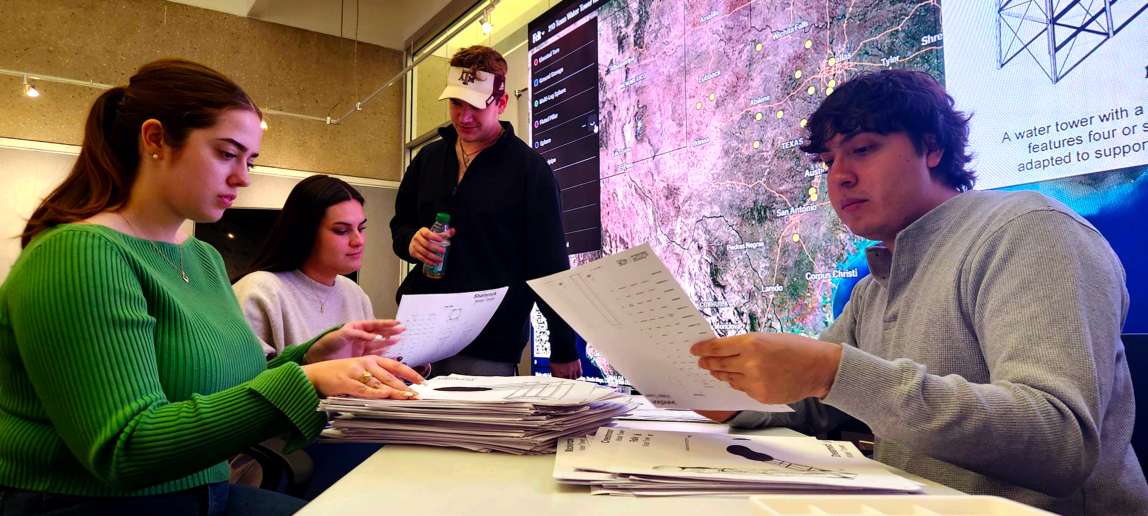Dreamed Water Towers: Reimagining Texas Infrastructure
A New Purpose for a Familiar Icon
What if one of Texas’ most recognizable structures could help solve the challenges of tomorrow?
More than 1,000 water towers rise above Texas towns and cities. Painted with mascots, logos and local pride, they quietly store water, stabilize pressure and support communities during power outages. But what if these utilitarian structures could do more?
That question drove a senior architecture studio at Texas A&M University, where students reimagined water towers as tools for climate resilience, civic engagement and environmental innovation. Titled Dreamed Water Towers, the course was led by Visiting Associate Professor María Peñalver Izaguirre.
“We propose prototypes and explore how these towers could play a critical role in future environmental strategies,” Peñalver said. “This is not just an exploration of infrastructure; it’s a chance to reimagine the future of Texas’s landscape through design driven by aspirations or the desire to inspire hope.”
Uncovering Potential
The studio, ARCH 406, brought together 15 graduating architecture students for a semester-long design challenge. Their task: study the current state of water towers across Texas and imagine how they might evolve to meet the needs of 2050.
“The most challenging part of this project was choosing a modern issue that Texas faces,” said Katherine Isakson ’25. “Dramatizing it without becoming fictional, and creating a logical solution to this problem in 2050.”
Students considered how water towers—typically seen as purely functional—could take on new roles, from ecological repair to public space.
As a visiting professor from Spain, Peñalver encouraged students to approach the problem from unfamiliar angles, questioning assumptions about infrastructure and its potential.
A Studio in Two Acts
Documenting the Present
The semester began with a focused research phase. Inspired by photographers Bernd and Hilla Becher, famous for capturing industrial architecture in black-and-white typologies, each student studied 14 water towers from across Texas. In total, the class analyzed 210 towers, collecting data and creating detailed drawings to better understand each structure’s form, function and cultural context.
Working in a unified grayscale graphic style, students documented factors such as age, shape, location, purpose and symbolic meaning. By visually standardizing their work, they highlighted how this seemingly uniform infrastructure can reflect the distinct character of local communities.
“It was unique in that it challenged my graphic capability to design and draw in a style that was uniform to a collective,” said Paige Barrow ’25.
The class’s research was also supported by a custom interactive map, which visualized the towers’ distribution across the state.
Preview the map with the following image and explore it here: Texas Water Tower Map.
Designing the Future
In the second half of the course, students looked ahead. They were asked to imagine Texas in 2050 and redesign water towers to meet the social and environmental challenges of that future.
Some towers became community gathering places. Others incorporated renewable energy systems, urban agriculture or ecological features like rainwater harvesting and pollinator habitats.
“The intention in our individual project was to discuss the importance of infrastructure in the event of environmental and social crisis,” Barrow said.
To communicate their visions, students created drawings, models and narrative concepts that combined creativity with realism.
Why It Matters
Rather than seeing infrastructure as static, students were encouraged to think of it as adaptable. Water towers, once background features of the landscape, became platforms for innovation.
“Students define projects that are not only functional but also aim to provoke reflection or challenge conventional boundaries,” Peñalver said. “They sharpen their skills in creating new narratives, drawing, model making and representation.”
Looking Ahead
The studio concluded with a final review on April 25. While the course has ended, there is interest in continuing the research and submitting the work to the 2026 World Congress of Architects in Barcelona.
Learn more about this event: uia2026bcn.org
As Texas prepares for an uncertain future, Dreamed Water Towers reminds us that even the most ordinary infrastructure can inspire extraordinary ideas. The question isn’t just “What is a water tower?”—but “What could it become?”
Additional Resources
Browse through student work with the following documents:
- File representing work from Madison Rose, Morgan Clifton, and Haley Brynne
- File representing work from Mary Davis, Nallely Gonzalez, and Miguel Perez
- File representing work from Nathan Benton, Emma Sharpe, Katherine Isakson
- This project was awarded Honorable Mention among all fourth-year projects from Spring 2025 during the Department of Architecture’s Excellence Ceremony on Wednesday, May 7th.


